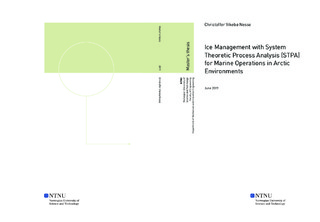| dc.description.abstract | Det siste hundreåret har Arktis vore forlokkande for modige forskarar og eventyrarar, men utilgjengeleg for dei fleste. Klimaendringar og framsteg i teknologi endrar dette raskt, noko som gjer den arktiske regionen meir tilgjengeleg. For industri opnar denne endringa opp for nye moglegheiter. Bruk av Nordvestpassasjen gjennom Arktis, som i utgangspunktet er ein snarveg, er av stor interesse for alle som på eitt eller anna vis er involvert i, eller dreg nytte av, global handel. Om lag ein sjettedel av verdas uoppdaga hydrokarbon samt andre mineral er òg å finne nord for Polarsirkelen, ressursar som truleg må utvinnast over tid for å møte framtidige energibehov.
Marine operasjonar i Arktis må handtere både tøffe vêrforhold og isforhold som sjøis og isfjell. Isstyring (ice management) er alle tiltak ein kan gjere for å redusere risiko ved isforhold, og er nødvendig for å sikre trygge marine operasjonar. I denne masteroppgåva har eg gått gjennom toppmoderne forsking som er relevant for isstyring, og funne ut at det er fleire utfordringar som framleis må løysast. Effektiv isstyring er avhengig av påliteleg overvaking av is, noko som i seg sjølv er vanskeleg å få til. Store mengder data vert samla og omsett til avgjerd- og navigasjonsstøtte for mannskap på fartøy i transitt gjennom Arktis, eller på isbrytarar som vernar ulike flytande konstruksjonar frå isforhold. Berekningsverktøy og numeriske simuleringsverktøy vert nytta til å evaluere og identifisere truslar og farlege hendingar. Dei fleste av desse er ikkje offentleg eller kommersielt tilgjengelege (endå), og blir stadig forbetra. Det er sannsynleg at desse simuleringsverktøya kan vere kjelde til nye typar feil.
I denne masteroppgåva har eg identifisert nokre generelle utfordringar med isstyring. Nokre av desse er viktige når det gjeld å identifisere farar og for å bestemme korleis ein kan unngå eller redusere desse. Komplekse interaksjonar mellom komponentar, system og menneske kan føre til uidentifiserte farlege scenario. Tradisjonelle fareidentifikasjonsmetodar vart ikkje utvikla for å analysere moderne komplekse sosiotekniske system, slik som isstyringssystem, og fleire avgrensingar er identifiserte. Ei relativt ny tilnærming til fareidentifikasjon, systemteoretisk prosessanalyse (STPA) som er utvikla for å effektivt identifisere feil som moderne system introduserer, er lagt fram i denne masteroppgåva. Ein eksempelstudie om isstyring har blitt utført ved hjelp av STPA-metoden, og det er samanlikna med ein eksempelstudie med FMECA. I denne masteroppgåva har eg vurdert til kva grad STPA skal nyttast til isstyring, om metoden skal nyttast i kombinasjon med andre meir tradisjonelle metodar, eller om den ikkje skal nyttast i det heile. | |
| dc.description.abstract | For the past century, the Arctic has been attracting brave researchers and adventurers, but inaccessible for most. Advancements in technology and changes in the climate are rapidly changing this, making the Arctic region more accessible. For the industry, this change is desirable. Usage of the Northern Sea Route through the Arctic, which is a shortcut, is of great interest to everyone somehow involved in or benefiting from global trade. Also, approximately a sixth of the world's undiscovered hydrocarbons and other minerals may be found north of the Arctic Circle, resources that might need to be extracted over time to meet future energy demands.
Marine operations in harsh Arctic environments must handle severe weather and ice conditions. Ice management is all measures that can be made to reduce risk from any ice feature and is necessary to ensure safe marine operations. In this master thesis, I have scratched the surface of the state of the art research relevant to ice management and found that many challenges remain to be solved. Efficient ice management operations depend on reliable monitoring and surveillance of ice features, which in itself is difficult to accomplish. Large amounts of data are gathered and translated into decision, and navigational support for the crew's on vessels in transit through the Arctic, or on icebreakers protecting different floating structures from ice conditions. Computational and numerical simulation tools are used to evaluate identified threats and hazardous situations. Most of these are not publicly accessible, or commercially available (yet), and are also subject to improvement. These simulation tools may likely be a source of new flaws.
In this master thesis, I have identified some general challenges concerning ice management, and some of these are of importance when it comes to identifying hazards, and to determine how these should be avoided or mitigated. Complex component, system and human interactions might lead to unidentified hazardous scenarios. Traditional hazard identification methods were not developed for the intent of analysing modern complex sociotechnical systems, which ice management systems are, and several limitations are identified. A rather novel approach to hazard identification, system-theoretic process analysis (STPA) has been developed to efficiently identify flaws that modern systems introduces, are presented in this master thesis. A case study on ice management have been conducted using the STPA method, and it is compared to a case study using FMECA. In this master thesis, I have evaluated whether or not STPA should be applied to ice management, if it should be used in combination with other methods, or if it is not suited whatsoever. | |
